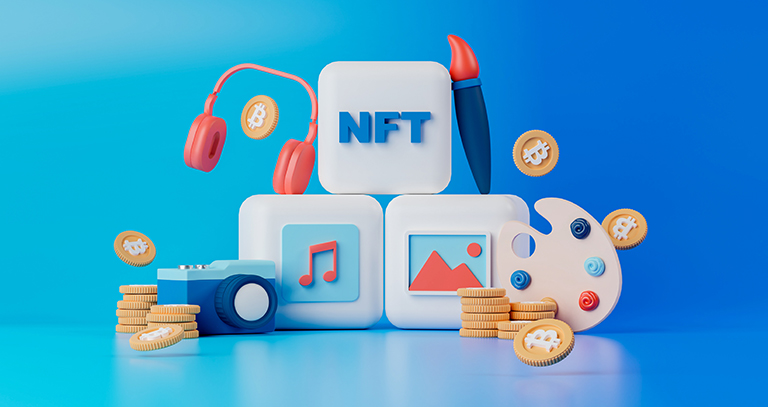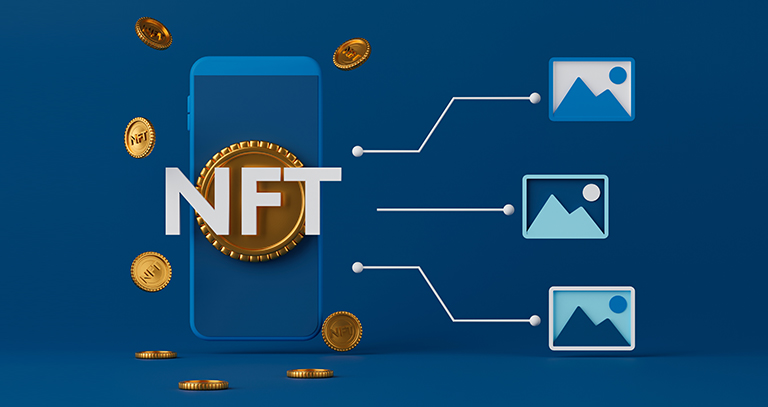Finance technology together called fintech, is actually not new to innovation. Over the past few years, the fintech revolution has gone way higher. The way we handle money from cash to cashless payments through digital wallets, shows how we have grown in technology. But one of the most intriguing developments in the intersection of finance and technology in recent years has been the rise of non-fungible tokens, or NFTs, as a novel way to invest in and interact with art. NFTs, built on blockchain technology, have ushered in a new era where art and finance converge in ways we could have never imagined.
In this blog post, we will explore the fascinating world of NFTs, how they work, and their impact on the art world and fintech. We will delve into the underlying blockchain technology, the challenges and controversies surrounding NFTs, and the potential future of this innovative space.
What Are NFTs?
These are quirky forms of digital assets. Unlike cryptocurrencies like Bitcoin or Ethereum, which are fungible and can be exchanged on a one-to-one basis, NFTs are one-of-a-kind digital tokens that represent ownership of a specific item, whether it’s a piece of digital art, a video clip, music, virtual real estate, or any other digital or physical object. NFTs use blockchain technology to establish ownership and prove the scarcity of digital items.
Here’s a simple breakdown of how NFTs work:
Creation: An artist or creator generates a digital file, which can be an image, video, audio, or any digital content.
Tokenization: The creator then mints the digital file into an NFT. This process involves converting the digital file into a unique token on a blockchain. This token includes metadata that verifies its uniqueness, ownership, and provenance.
Ownership and Transactions: Once minted, the NFT is sold or auctioned in online marketplaces like OpenSea, Rarible, or NBA Top Shot. Buyers use cryptocurrencies like Ethereum to purchase NFTs, and the blockchain records the transaction, establishing ownership.
Provenance and Authenticity: The blockchain ledger, which is publicly accessible, preserves a transparent and immutable history of the NFT, confirming its authenticity and ownership.
NFTs have introduced a new paradigm in the world of art and digital content ownership. Creators can now monetize their work directly, bypassing traditional middlemen like galleries and record labels. Buyers, in turn, get to own a unique piece of digital or virtual art.

Fintech Meets NFTs
The convergence of NFTs and fintech is groundbreaking. Here are some ways in which fintech has embraced NFTs:
1. Digital Wallets and Crypto Payments
Fintech has long been associated with digital wallets and cryptocurrency. These technologies enable seamless transactions, which is precisely what NFTs require. NFT marketplaces usually accept cryptocurrencies like Ethereum for buying and selling digital assets. Digital wallets can store both cryptocurrencies and NFTs, making it easy for users to manage their digital art collections alongside their crypto holdings.
2. Fractional Ownership
Fintech platforms have explored fractional ownership of high-value NFTs. Fractionalization allows investors to buy shares in an NFT, making art and other rare assets more accessible. This innovation could democratize art investment and unlock new opportunities for retail investors.
3. DeFi and NFT Lending
DeFi (Decentralized Finance) platforms, another fintech innovation, have started incorporating NFTs into their lending and borrowing protocols. NFTs can be used as collateral for loans, allowing asset owners to leverage their digital art collections for liquidity without selling their tokens.
4. Marketplaces and Exchanges
The NFT ecosystem has grown rapidly, with various marketplaces and exchanges offering a wide range of digital assets. Fintech companies have played a significant role in developing these platforms, enabling the seamless trading and exchange of NFTs.
5. NFT Investment Funds
Fintech companies have also begun to create investment products that focus on NFTs. These funds pool capital from investors and use it to purchase NFTs, aiming to generate returns as the value of the underlying assets appreciates.
Blockchain Technology: The Backbone of NFTs
NFTs rely on blockchain technology for their existence. Blockchain is a distributed ledger technology that securely and openly records transactions on several computers. This technology underpins the creation, ownership, and security of NFTs.
Here are some key aspects of blockchain technology’s role in NFTs:
1. Security and Transparency
Blockchains offer security through encryption and decentralization. Each transaction involving an NFT is recorded on the blockchain, creating an immutable and publicly accessible ledger. This transparency and security are critical in establishing the authenticity and ownership of NFTs.
2. Interoperability
NFTs can be created on different blockchains, including Ethereum, Binance Smart Chain, and Flow, among others. Interoperability allows NFTs to be transferred between different blockchain networks, increasing their versatility.
3. Smart Contracts
Smart contracts, self-executing agreements with the terms of the contract directly written into code, are an integral part of NFTs. They automate the minting, buying, selling, and transferring of NFTs, reducing the need for intermediaries.
4. Provenance and Scarcity
Blockchain technology enables NFTs to prove their provenance and scarcity. The entire history of an NFT, from its creation to its current owner, is traceable on the blockchain. This guarantees the uniqueness and authenticity of the asset.
The use of blockchain technology is not limited to NFTs alone. It has broader applications in fintech, such as cross-border payments, identity verification, and supply chain management.

The Future of NFTs in Fintech
The intersection of NFTs and fintech is still in its early stages, and the future is full of possibilities:
1. Integration with Traditional Finance
As NFTs become more mainstream, traditional financial institutions may explore ways to integrate them into their services. This could include banks offering NFT custody, investment products, and loans against NFT collateral.
2. Enhanced Security and Compliance
With regulatory bodies increasingly scrutinizing the NFT space, fintech companies will likely invest in developing solutions for ensuring compliance and security. These solutions could include identity verification and fraud prevention tools.
3. Expansion of NFT Use Cases
The use cases for NFTs are far from exhausted. NFTs could be applied to a broader range of assets, including real estate, collectibles, and virtual goods in the gaming industry. This expansion will bring more innovation and opportunities for fintech companies.
4. Continued Artistic and Cultural Impact
NFTs have already disrupted the art world, enabling artists to connect directly with their audience and gain more control over their work. The continued growth of NFTs could redefine how we think about ownership and authenticity in the digital age.
5. Ethical and Environmental Considerations
The NFT space is increasingly aware of its environmental footprint. Ethical and sustainable practices in blockchain technology, such as transitioning to PoS blockchains, will play a vital role in shaping the industry’s future.
Rundown
The fusion of NFTs and fintech represents an exciting frontier in the world of finance and technology. NFTs have revolutionized the way we invest in and appreciate art, offering creators new avenues for monetization and buyers the chance to own unique digital assets. As technology matures and addresses its challenges, it is poised to play an even more significant role in the financial world. The future of NFTs in fintech holds immense promise, and it’s a space worth watching as it continues to evolve and expand.




